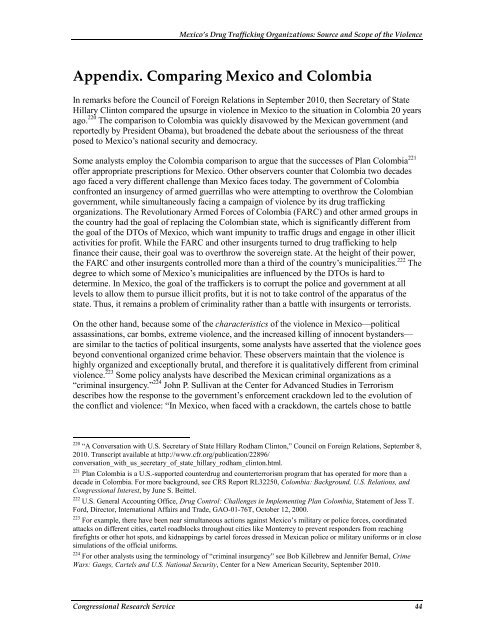Mexico's Drug Trafficking Organizations - Federation of American ...
Mexico's Drug Trafficking Organizations - Federation of American ...
Mexico's Drug Trafficking Organizations - Federation of American ...
You also want an ePaper? Increase the reach of your titles
YUMPU automatically turns print PDFs into web optimized ePapers that Google loves.
Mexico’s <strong>Drug</strong> <strong>Trafficking</strong> <strong>Organizations</strong>: Source and Scope <strong>of</strong> the Violence<br />
Appendix. Comparing Mexico and Colombia<br />
In remarks before the Council <strong>of</strong> Foreign Relations in September 2010, then Secretary <strong>of</strong> State<br />
Hillary Clinton compared the upsurge in violence in Mexico to the situation in Colombia 20 years<br />
ago. 220 The comparison to Colombia was quickly disavowed by the Mexican government (and<br />
reportedly by President Obama), but broadened the debate about the seriousness <strong>of</strong> the threat<br />
posed to Mexico’s national security and democracy.<br />
Some analysts employ the Colombia comparison to argue that the successes <strong>of</strong> Plan Colombia 221<br />
<strong>of</strong>fer appropriate prescriptions for Mexico. Other observers counter that Colombia two decades<br />
ago faced a very different challenge than Mexico faces today. The government <strong>of</strong> Colombia<br />
confronted an insurgency <strong>of</strong> armed guerrillas who were attempting to overthrow the Colombian<br />
government, while simultaneously facing a campaign <strong>of</strong> violence by its drug trafficking<br />
organizations. The Revolutionary Armed Forces <strong>of</strong> Colombia (FARC) and other armed groups in<br />
the country had the goal <strong>of</strong> replacing the Colombian state, which is significantly different from<br />
the goal <strong>of</strong> the DTOs <strong>of</strong> Mexico, which want impunity to traffic drugs and engage in other illicit<br />
activities for pr<strong>of</strong>it. While the FARC and other insurgents turned to drug trafficking to help<br />
finance their cause, their goal was to overthrow the sovereign state. At the height <strong>of</strong> their power,<br />
the FARC and other insurgents controlled more than a third <strong>of</strong> the country’s municipalities. 222 The<br />
degree to which some <strong>of</strong> Mexico’s municipalities are influenced by the DTOs is hard to<br />
determine. In Mexico, the goal <strong>of</strong> the traffickers is to corrupt the police and government at all<br />
levels to allow them to pursue illicit pr<strong>of</strong>its, but it is not to take control <strong>of</strong> the apparatus <strong>of</strong> the<br />
state. Thus, it remains a problem <strong>of</strong> criminality rather than a battle with insurgents or terrorists.<br />
On the other hand, because some <strong>of</strong> the characteristics <strong>of</strong> the violence in Mexico—political<br />
assassinations, car bombs, extreme violence, and the increased killing <strong>of</strong> innocent bystanders—<br />
are similar to the tactics <strong>of</strong> political insurgents, some analysts have asserted that the violence goes<br />
beyond conventional organized crime behavior. These observers maintain that the violence is<br />
highly organized and exceptionally brutal, and therefore it is qualitatively different from criminal<br />
violence. 223 Some policy analysts have described the Mexican criminal organizations as a<br />
“criminal insurgency.” 224 John P. Sullivan at the Center for Advanced Studies in Terrorism<br />
describes how the response to the government’s enforcement crackdown led to the evolution <strong>of</strong><br />
the conflict and violence: “In Mexico, when faced with a crackdown, the cartels chose to battle<br />
220 “A Conversation with U.S. Secretary <strong>of</strong> State Hillary Rodham Clinton,” Council on Foreign Relations, September 8,<br />
2010. Transcript available at http://www.cfr.org/publication/22896/<br />
conversation_with_us_secretary_<strong>of</strong>_state_hillary_rodham_clinton.html.<br />
221 Plan Colombia is a U.S.-supported counterdrug and counterterrorism program that has operated for more than a<br />
decade in Colombia. For more background, see CRS Report RL32250, Colombia: Background, U.S. Relations, and<br />
Congressional Interest, by June S. Beittel.<br />
222 U.S. General Accounting Office, <strong>Drug</strong> Control: Challenges in Implementing Plan Colombia, Statement <strong>of</strong> Jess T.<br />
Ford, Director, International Affairs and Trade, GAO-01-76T, October 12, 2000.<br />
223 For example, there have been near simultaneous actions against Mexico’s military or police forces, coordinated<br />
attacks on different cities, cartel roadblocks throughout cities like Monterrey to prevent responders from reaching<br />
firefights or other hot spots, and kidnappings by cartel forces dressed in Mexican police or military uniforms or in close<br />
simulations <strong>of</strong> the <strong>of</strong>ficial uniforms.<br />
224 For other analysts using the terminology <strong>of</strong> “criminal insurgency” see Bob Killebrew and Jennifer Bernal, Crime<br />
Wars: Gangs, Cartels and U.S. National Security, Center for a New <strong>American</strong> Security, September 2010.<br />
Congressional Research Service 44















